
Estrogen dominance – it’s the most common hormone imbalance for women in their 40s and has symptoms that will sound familiar to many of you – but many women don’t realize this imbalance even exists. So let’s shed some light on this imbalance so that no woman has to suffer in silence anymore.
Women’s Hormones 101
To understand estrogen dominance, first we have to start with a quick refresher on our two primary female hormones – estrogen and progesterone.
Estrogen is the main hormone in the first half of our menstrual cycle and causes the lining of the uterus to thicken. Estrogen is produced by the ovaries, but also by fat cells. Estrogen levels can also be raised by exposure to xenoestrogens – compounds in our environment that look like estrogen and are able to bind to estrogen receptors.
Progesterone is the main hormone in the second half of our cycle, and supports implantation and pregnancy. Increases in progesterone signal the body to stop making so much estrogen. Progesterone is made almost completely by the ovaries, but small amounts can be made in the adrenal glands as well.
WTF is Estrogen Dominance?
 Women are born with all their eggs – so the eggs we ovulate each month have been along for the entire ride of our lives. As our eggs age their quality decreases – this has two major impacts that set us up for estrogen dominance.
Women are born with all their eggs – so the eggs we ovulate each month have been along for the entire ride of our lives. As our eggs age their quality decreases – this has two major impacts that set us up for estrogen dominance.
- Older eggs take longer to mature – an older egg may be slower to reach maturity – this causes the brain to produce higher levels of FSH (follicle stimulating hormone) to attempt to mature the egg. The higher the FSH, the more follicles that are stimulated and the higher the estrogen production.
While many women believe estrogen levels decline in our 40s, the opposite is in fact true. Estrogen levels only significantly decline at menopause.
- Older eggs produce less progesterone – one of the main reasons our fertility drops off with age is that our older eggs make less progesterone. This drop in progesterone production can impact much more than our fertility – it is also the reason that PMS is more intense in our 40s and sets the stage for estrogen dominance.
Estrogen dominance is the state where estrogen levels are not balanced by progesterone levels – too high estrogen and too low progesterone. And this is where the chaos begins…
Symptoms of Estrogen Dominance
Not sure yet if you are dealing with estrogen dominance? Read these symptoms and see if they ring true for you.
- Anxiety
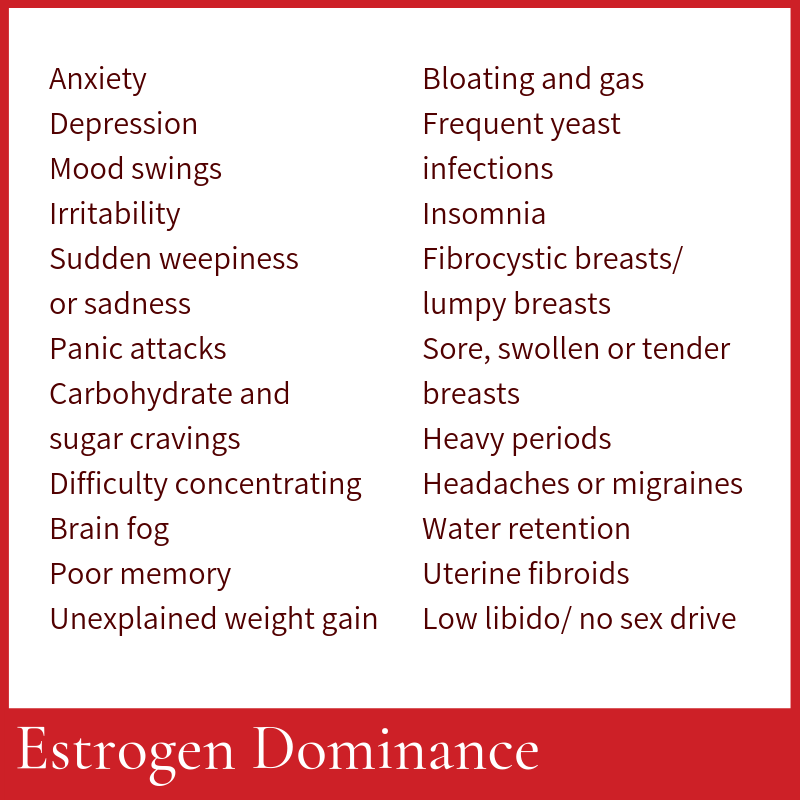
- Depression
- Mood swings
- Irritability
- Insomnia
- Bloating
- Carbohydrate and sugar cravings
- Difficulty concentrating
- Brain fog
- Weight gain or difficulty losing weight
- Frequent yeast infections
- Joint pain or inflammation
- Heavy or irregular periods (longer or shorter cycles)
- More PMS
- Headaches and migraines premenstrually
- Swelling and water retention
- Lack of sex drive/ low libido
- Breast tenderness or swelling
- Uterine fibroids
Why Haven’t I Heard of Estrogen Dominance?
Unfortunately a woman who presents to her doctor with the symptoms listed above will often be dismissed (It’s just stress! You’re getting older – it happens), be given an antidepressant, be put on the birth control pill (to “regulate” hormones) or told to relax, lose weight, or get counseling. Very rarely will a doctor delve into the hormonal fluctuations with hormone testing, or even discuss the likely imbalances that occur in our 40s.
Testing for Estrogen Dominance
For some women the symptoms are so clear that testing may not be necessary. But for most women, hormone testing is recommended to get a clear picture of what her individual hormone balance is, and to develop a plan that will help to restore her personal hormone harmony.
 Hormone testing can be done via blood tests, saliva tests or the DUTCH urine test. I go into greater detail on hormone testing in this article: Hormone Testing Options
Hormone testing can be done via blood tests, saliva tests or the DUTCH urine test. I go into greater detail on hormone testing in this article: Hormone Testing Options
For any hormone test that is done, the most important thing to look for is balance. Many women are dismissed as “normal” when their hormone values are all within the normal limits. But more important than the actual value of the hormones, is the balance between the hormones. If estrogen is normal but progesterone is very low, estrogen dominance occurs. If estrogen is high but progesterone is normal, estrogen dominance occurs. You need to ensure that whoever is interpreting your tests with you has a great deal of knowledge on hormone balance.
It’s Not Just About Your Periods
As you can see from the list of symptoms above, estrogen dominance impacts a lot more than just our periods and our PMS. All our hormones function in harmony with each other – and when one hormone is imbalanced, there can be significant ripple effects on the other hormones. Below are just a few:
Estrogen dominance worsens hypothyroid – high levels of estrogen lead to an increased clearance of our energizing thyroid hormones – this can lead to symptoms of hypothyroidism (fatigue, brain fog, weight gain, hair loss) or worsen symptoms in women who have this condition
Estrogen dominance is worsened by stress – increased production of cortisol, as occurs during times of stress, lowers progesterone levels. Cortisol also competes with progesterone for receptors – which can cause symptoms of estrogen dominance even when progesterone levels are adequate. This can worsen symptoms of stress like irritability, decreased coping, fatigue and overwhelm.
Treatment of Estrogen Dominance
When we are treating estrogen dominance we have two main goals in mind – lower the estrogen and increase the progesterone.
Lowering Estrogen
 Decrease exposure to xenoestrogens – Commonly found in plastics, personal care products and household cleaners, avoiding exposure to the synthetic estrogens that are abundant in our environment is an essential first step.
Decrease exposure to xenoestrogens – Commonly found in plastics, personal care products and household cleaners, avoiding exposure to the synthetic estrogens that are abundant in our environment is an essential first step.- Support estrogen detoxification – B vitamins, probiotics, brassica vegetables, DIM and 13C are all essential for allowing your body to clear the estrogen and restore balance to your body. Your Naturopathic Doctor will help you to determine what the best choices are for you – but starting with a B complex supplement, a probiotic and choosing more foods in the cabbage family (broccoli, cauliflower, kale, cabbage, Brussels sprouts) is recommended.
Increasing Progesterone
 Make sure you can make it – essential nutrients for the production of progesterone include B vitamins (especially vitamin B6), and magnesium. So ensuring you have an abundance of these in your diet, or in supplement form, is important for overcoming estrogen dominance.
Make sure you can make it – essential nutrients for the production of progesterone include B vitamins (especially vitamin B6), and magnesium. So ensuring you have an abundance of these in your diet, or in supplement form, is important for overcoming estrogen dominance.- Bioidentical progesterone cream – sometimes the only way to overcome estrogen dominance is to add back some of what we need – progesterone. Available in Canada as a prescription from your Naturopath, bioidentical progesterone provides your body with the progesterone you no longer make as easily. It can be a life changing treatment for many women in their 40s.
Harmonizing Hormones
Our 40s as women can be a tumultuous time – raising children, achieving career success, supporting spouses, aging parents – any number of significant life events. But our hormones don’t need to be tumultuous. We can support our bodies and our minds by focusing on achieving our individual hormone harmony. If you want to discuss more about your hormone health, book a free meet and greet or an appointment today.
Disclaimer
The advice provided in this article is for informational purposes only. It is meant to augment and not replace consultation with a licensed health care provider. Consultation with a Naturopathic Doctor or other primary care provider is recommended for anyone suffering from a health problem.





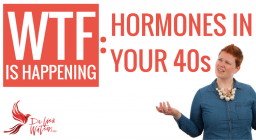





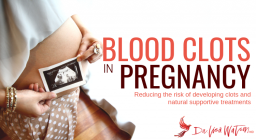

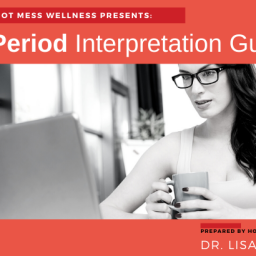
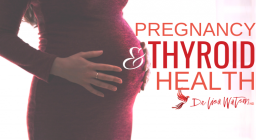


Hi, I have problems with my period. Its been 2 months i didn’t get my period. I found there’s some hair grow (abdomen area) and this make me feel worry. What should I do?
I suggest you consider getting tested for PCOS. That condition is associated with irregular or absent periods, and overgrowth of hair in a male pattern (upper lip, chin, chest, belly). You can learn more about PCOS testing here: http://drlisawatson.com/diagnosing-pcos
[…] levels of estrogen, or estrogen dominance, majorly impacts our ability to breakdown histamine, leaving women in their 30s and 40s especially […]
[…] you know from all the previous articles on my website, high estrogen and low progesterone are the dominant hormone changes in our late 30s and 40s, while low estrogen and low progesterone […]